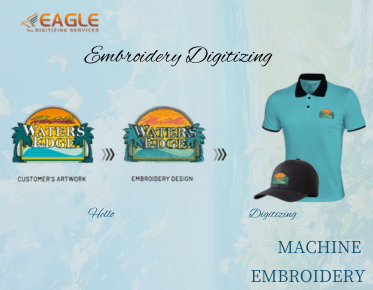How embroidery digitizing helps clothing companies seize opportunities in the custom t-shirt market
T-shirt design has come a long way from basic prints and graphics. Today, it’s a dynamic and vibrant form of self-expression, with custom designs that showcase individuality, brand identity, and artistic flair. The digital revolution has played a major role in this transformation, particularly through embroidery digitizing, a technology that allows clothing companies to create intricate and detailed designs that stand out in a saturated market. This evolution is not just about aesthetics, but also about the deeper cultural shifts that influence fashion trends, with t-shirts serving as a way to communicate personal beliefs, affiliations, and even social movements. Whether it’s a bold statement or a subtle expression, custom t-shirts have become a canvas for creativity that continues to inspire both designers and wearers.
The Rise of Custom Apparel: T-shirts as Personal Statements
T-shirts have evolved from mere garments into a canvas for personal expression. What started as a practical, everyday piece of clothing has now become a statement of personality, values, and creativity. Custom t-shirts allow individuals to showcase their unique style, whether it’s through bold graphics, clever slogans, or intricate artwork. These designs offer a way for people to stand out, share their passions, or even make a statement about the world around them. In recent years, this shift has become more apparent in popular culture, where t-shirts are often used to reflect personal stories, movements, and individual preferences in fashion. As brands catch on, custom apparel is transforming into an essential part of how we communicate without words, enabling people to express themselves in ways that transcend traditional fashion.
Embroidery Digitizing: The Secret Sauce for Unique Custom T-Shirts
While graphic printing has been a popular method for creating custom designs, embroidery has emerged as a premium option that offers sophistication, durability, and texture. However, the real magic lies in embroidery digitizing—technology that takes embroidery to the next level. By converting designs into a format that machines can read and execute, digitizing allows intricate details and textures to be woven directly into the fabric. This advancement not only makes t-shirt designs stand out but also ensures they have the longevity and quality that consumers now expect from premium products. With embroidery digitizing, businesses can create one-of-a-kind items that attract attention with their depth, texture, and elegance, transforming a simple tee into an art piece.
What is Embroidery Digitizing and Why It’s Essential
Embroidery digitizing is the process of converting digital artwork into a set of instructions for an embroidery machine. These instructions guide the machine on where to place each stitch, the type of stitch to use, and the thread colors to employ. Without digitizing, translating a detailed design into a fabric-friendly format would be nearly impossible, especially for complex or multi-colored patterns. The precision of this technology ensures that every detail, from tiny text to intricate logos, is captured in the final product, resulting in professional-quality embroidery. As demand for customized apparel grows, embroidery digitizing provides the versatility and efficiency that clothing companies need to stay competitive and meet customer expectations for high-quality, personalized designs.
Transforming Art into Thread: The Magic Behind the Process
The art of embroidery digitizing is nothing short of magical. What starts as a flat, digital image is converted into a beautiful, tactile design, rich with texture and depth. The process begins with an artist or designer creating a digital image, which is then uploaded into specialized software. The software breaks the image down into a series of commands—defining stitch types, directions, and colors—that an embroidery machine can follow. The software also ensures that every detail is in line with the original vision, transforming a digital idea into a multi-dimensional reality. This blend of artistry and technology enables a seamless transition from concept to creation, allowing for the design to be realized in thread as intended, with every detail intact.
Unlocking Creativity: Pushing the Boundaries of Design
Embroidery digitizing isn’t just about transferring a design onto fabric; it’s about pushing the boundaries of what’s possible. With the ability to control stitch types, densities, and directions, designers can experiment with textures, patterns, and effects that would have been difficult to achieve using traditional methods. Digitizing enables a greater level of flexibility, allowing for complex layers and textures that bring designs to life. As technology advances, the opportunities to innovate and create truly one-of-a-kind pieces have expanded, enabling designers to incorporate effects that challenge the traditional norms of embroidery. This creative freedom opens new doors for personalized designs, as each t-shirt can now embody a unique, artistic vision that reflects the wearer’s individuality.
From Simple Graphics to Intricate Works of Art
What once might have been a simple logo or graphic can now be transformed into an intricate work of art. Digitizing opens up a world of possibilities, enabling designers to incorporate fine details such as gradients, fine lines, and textures. Whether it's adding shadows, creating depth, or using multiple thread colors for a multicolor design, embroidery digitizing allows for more complex designs that catch the eye and stand out from standard printed designs. The evolution of this technology has made it possible for even the most intricate details to be reproduced on fabric, ensuring that every design has a polished, professional finish. As consumers’ tastes become more sophisticated, this level of artistry ensures that custom t-shirts continue to be a popular medium for personal expression.
How Digitizing Turns Concepts into Complex Stitching Patterns
The true artistry of embroidery lies in the way it can take abstract concepts and turn them into concrete designs. Digitizing software allows designers to create detailed stitching patterns that align perfectly with the original concept. For instance, a floral pattern can be transformed into a series of overlapping satin stitches and running stitches that add both texture and dimension to the design. These intricate patterns are not only visually appealing but also durable, ensuring the design lasts for years to come. Digitizing gives the designer the ability to visualize and perfect the design at every step of the process, leading to a final product that is both artistically beautiful and functionally durable.
Stitching Precision: Achieving Professional-Level Detail
Embroidery digitizing allows for precision at a once unattainable level. The stitching process itself is highly detailed, with every stitch placement optimized for clarity and definition. This level of precision ensures that even the finest details of a design—whether it's small text, intricate borders, or fine lines—are executed flawlessly. The machine's ability to repeat these placements consistently guarantees a high level of uniformity, ensuring that each custom t-shirt reflects the designer's vision. As a result, clothing companies can deliver high-quality, professional-grade products that stand out in a competitive market, offering a level of detail and refinement that was once only achievable through painstaking handwork.
The Role of Stitch Density and Direction in Custom T-Shirts
Stitch density plays a crucial role in the outcome of an embroidered design. By controlling how closely the stitches are placed together, designers can adjust the texture, appearance, and durability of the design. Dense stitching creates a more textured, raised effect, while looser stitching gives a softer, more delicate feel. The strategic placement of stitches also helps to define the contours and shadows in a design, adding a sense of dimension that is impossible with flat printing techniques. Direction is equally important—how stitches are laid out with one another. can impact the flow and overall look of the design. A skilled digitizer can manipulate both density and direction to create the perfect balance between artistry and functionality, ensuring that every design achieves its full visual potential.
Precision vs. Tradition: How Technology Makes the Difference
Traditional embroidery was a painstaking, manual process that required years of skill to master. However, technology has streamlined this process, making it possible to achieve greater precision and complexity in a fraction of the time. While traditional methods still have their place, modern embroidery digitizing offers a level of precision that allows designers to perfect even the most intricate designs, without compromising on speed or efficiency. The combination of advanced software and automated machines means that companies can produce high-quality custom t-shirts more consistently, ensuring that every product meets the highest standards. This technological advancement allows businesses to fulfill larger orders without sacrificing the craftsmanship and attention to detail that defines premium designs.
Boosting Efficiency and Reducing Production Time
Faster Turnaround Times Without Sacrificing Quality
One of the major advantages of embroidery digitizing is its ability to speed up the production process without sacrificing quality. Designs that would have taken hours or even days to complete manually can now be executed by machines in a fraction of the time. This shift has made it possible for companies to fulfill large orders quickly and efficiently, meeting customer demand without delays. While manual methods are still appreciated for their craftsmanship, digitizing provides a level of speed and scalability that modern businesses require to stay competitive. By reducing production time, businesses can maximize profits and improve customer satisfaction, ensuring that custom t-shirts are delivered on time, every time.
How Digitizing Cuts Down on Manual Labor and Increases Productivity
By automating much of the embroidery process, digitizing reduces the need for manual labor, which can be both time-consuming and error-prone. Machines can quickly and accurately replicate designs with minimal human intervention, allowing clothing companies to fulfill large orders with greater efficiency. This increased productivity leads to faster turnaround times, making it easier for companies to meet customer demands and stay competitive. Additionally, because the process is automated, there is a significant reduction in the likelihood of mistakes, which ultimately lowers the cost of production and enhances overall profitability. Digitizing empowers businesses to handle more orders in less time, ensuring that they can scale operations to meet growing demand.
Meeting Market Demand: Scaling Custom T-Shirt Orders with Ease
From One-Offs to Large-Scale Production: Managing Bulk Orders
Custom t-shirt orders come in all shapes and sizes, from one-off designs to large-scale production runs. Embroidery digitizing allows companies to scale their operations effortlessly, ensuring that both small and large orders can be completed quickly and to the highest quality standards. With digitizing, designers can create master files that can be replicated consistently, making it easier to handle orders of any size. This scalability enables businesses to meet customer needs, whether they're fulfilling a batch of shirts for a boutique or producing thousands for a large corporate client. The ability to easily scale production helps clothing companies respond to market trends and seasonal demands while maintaining quality.
How Digitizing Makes Scaling Seamless for Clothing Companies
With digitizing, designers can create master files that can be replicated endlessly, ensuring consistency across large runs. Whether producing a small batch of shirts for a boutique or fulfilling a mass order for a corporate client, digitizing technology enables companies to meet any demand with ease. This flexibility is a game-changer for businesses that need to adapt quickly to changes in demand, enabling them to scale their operations without compromising on the quality of their designs. Additionally, the consistency of digitized designs means that every t-shirt, regardless of the order size, will look identical and maintain the same level of detail and precision.



